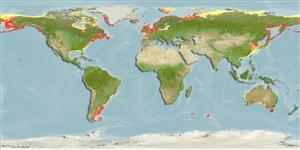Common names from other countries
Classification / Names / Names
Namen | Synonyme | Catalog of Fishes (gen., sp.) | ITIS | CoL | WoRMS
Environment: milieu / climate zone / depth range / distribution range
Ökologie
Pelagisch; tiefenbereich 0 - 85 m (Ref. 116114). Boreal; 81°N - 47°N, 34°W - 69°E
Arctic and Northeast Atlantic: from Iceland to France, north to Svalbard and east to Russia.
Length at first maturity / Size / Gewicht / Alter
Maturity: Lm ? range ? - ? cm Max length : 229 cm WD Männchen/unbestimmt; (Ref. 99323)
Diameter up to 100 cm; rhopalar and tentacular stomach pouches completely separated; peripheral canals more or less curved; without or with very few anastomoses; color reddish brown or yellowish.
The tentacle of the longest medusozoa meaures 36.6 m (Ref. 99323). The largest specimen observed was 2 meters wide (Ref. 121705).
Life cycle and mating behavior
Geschlechtsreife | Fortpflanzung | Ablaichen | Eier | Fecundity | Larven
Members of the class Scyphozoa are gonochoric. Life cycle: Egg is laid by the adult medusa which later develops into a free-living planula, then to a scyphistoma to a strobila, and lastly to a free-living young medusa.
Cairns, S.D., D.R. Calder, A. Brinckmann-Voss, C.B. Castro, D.G. Fautin, P.R. Pugh, C.E. Mills, W.C. Jaap, M.N. Arai, S.H.D. Haddock and D.M. Opresko. 2003. (Ref. 1663)
IUCN Rote Liste Status (Ref. 130435: Version 2024-1)
CITES Status (Ref. 108899)
Not Evaluated
Not Evaluated
Nutzung durch Menschen
| FishSource |
Tools
Internet Quellen
Estimates based on models
Verwundbarkeit
Very high vulnerability (90 of 100).
Preiskategorie
Unknown.
